SBIR/STTR PROGRAMS
NASA’s SBIR and STTR programs provide funding opportunities for small, technology-focused companies and research institutions to participate in government sponsored research and development (R&D) efforts in key technology areas. NASA takes zero equity. SBIR/STTR awardees can get up to $1 million over the first three years, plus up to $3 million, or more, in post Phase II opportunities.[1]
The NASA SBIR/STTR program has three phases, which is broken down in the Figure below.
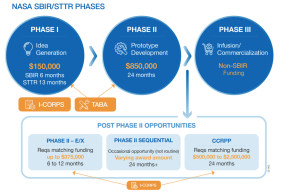
SBIR/STTR PROGRAMS
NASA’s SBIR and STTR programs provide funding opportunities for small, technology-focused companies and research institutions to participate in government sponsored research and development (R&D) efforts in key technology areas. NASA takes zero equity. SBIR/STTR awardees can get up to $1 million over the first three years, plus up to $3 million, or more, in post Phase II opportunities.[1]
The NASA SBIR/STTR program has three phases, which is broken down in the Figure below.
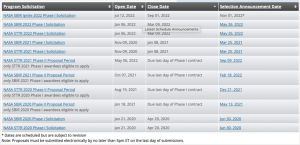
Source: NASA SBIR/STTR
NASA posted several FY23 budget documents, strategic plans, and performance reports online. The budgets from previous years can also be accessed. The FY23 budget request for SBIR/STTR was $285 million, $2 million less than FY22.[2]
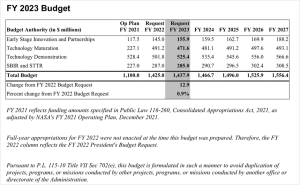
Source: NASA FY23 Budget Estimates
In FY21, NASA awarded 305 SBIR and 56 STTR Phase I contracts. The program also awarded 142 SBIR and 22 STTR Phase II contracts.[3] Redwire Industrial Crystallization Facility was one of NASA’s FY21 SBIR success stories, as highlighted by the budget report below.
The Redwire Industrial Crystallization Facility (ICF), developed in part with funding from NASA’s Small Business Innovation Research (SBIR) program, is an in-space manufacturing facility designed for the growth and formulation of large (centimeter-scale) single crystals and other exotic materials of industrially relevant size and quality. Following successful demonstrations, the T-CMM and ICF will be available for use by commercial customers.[4]
More FY21 achievements are outlined in the graphic below.
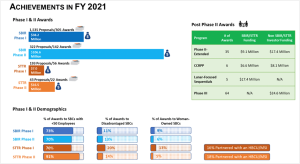
Source: NASA FY23 Budget Estimates
In FY21, the five states with the greatest number of awards were California, Colorado, Texas, Arizona, and Virginia – four of which earned more than $10 million. The map below shows the full award distribution with corresponding amounts.
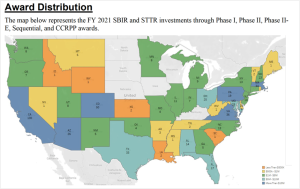
Source: NASA FY23 Budget Estimates
In FY22, the SBIR program planned to accelerate the technologies necessary to support the Artemis, climate, and clean energy objectives. The budget document also outlines the planned achievements for FY23, which include:
- The program office will place additional emphasis on engaging a broad, diverse base of innovators through the program, especially in engagements with MSIs, including HBCUs, in addition to an increased emphasis on entrepreneurial engagement to encourage commercialization and economic impact.
- The program office will streamline award vehicles, improve market simulation through a commercial-focused pilot, and support iTech as a way to develop the pipeline of entrepreneurial firms.
- Award amounts for Phase I and II awards, will be increased for the first time in ten years to enable firms to meet NASA's demanding technology needs.
- NASA will implement new legislative authorities, as signed into law, such as direct to Phase II awards and expanded CCRPP.
- The SBIR and STTR program office will continue to work with all the NASA mission directorates, centers, and industry to identify subtopics including technologies to support human exploration to the Moon and eventually Mars as well as climate and clean energy challenges.
- In addition, this program will support NASA's Artemis Program and climate and clean energy objectives by identifying and accelerating relevant technologies drawn from the SBIR portfolios through Post Phase II awards.
- The SBIR and STTR program office will explore new opportunities to seek, select, advance technology R&D from small businesses, research institutions, and entrepreneurs where there is both NASA and commercial sector interest. [5]
Updated November 2022 by Jennifer Ostromecki

Comments are closed.